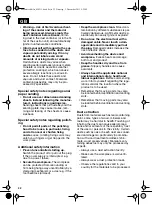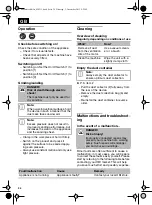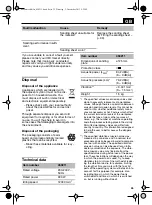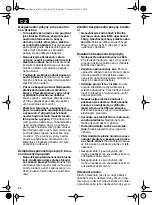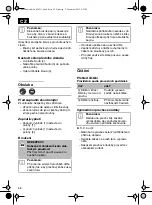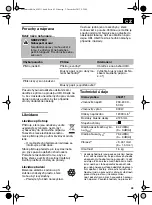
32
• Warning – risk of fire! Avoid overheat-
ing of the sander and the material
being processed. Always empty the
dust container before breaks.
Grind-
ing dust in the dust container (or in the fil-
ter of the suction unit) can automatically
ignite in unfavourable conditions.
• Inform yourself with regard to the sur-
face to be sanded and the dusts and
vapours potentially arising. If in any
doubt, do not inhale even small
amounts of arising dusts or vapours.
Harmful/toxic dusts may arise when
sanding certain surfaces (various metals,
minerals or woods as well as weather
protection coatings), which can cause
severe allergic reactions or serious ill-
ness. Do not inhale these dusts and
vapours and avoid contact. Materials
containing asbestos may only be pro-
cessed by specialists.
Special safety notes regarding sand-
paper sanding
• Do not use over dimensioned sanding
sheets, instead following the manufac-
turer’s instructions regarding size.
Sanding sheets that protrude beyond the
sanding plate may cause injuries, jam-
ming and tearing of the sheets or cause
kickback.
Special safety notes regarding polish-
ing
• Do not permit parts of the polishing
hood to be loose, in particular, fixing
cords. Conceal or shorten fixing
cords.
Loose, rotating fixing cords may
catch your fingers or get trapped in the
work piece.
Additional safety information
• Prevent uncontrolled starting up.
Switch the product off or pull out the plug
if the power supply is interrupted, e.g.
due to a power failure.
• Secure the workpiece.
The workpiece
can be protected from rebounding or
from being flung away uncontrollably by a
clamping mechanism or a vice (e.g. if the
tool becomes jammed).
• Keep the workplace clean.
Mixed con-
tamination by different substances is par-
ticularly dangerous. Light metal dust (e.g.
aluminium) can easily ignite or explode.
• Do not use the electrical tool with a
damaged cable. Never touch a dam-
aged cable and immediately pull out
the plug.
Damaged cables increase the
risk of electric shock.
• Avoid overheating the device and
workpiece.
Excess heat can damage
both tool and product.
• Keep the handles dry and free from
grease.
Slippery handles can cause
accidents.
• Always heed the applicable national
and international safety, health and
labour regulations.
Before commencing
work, inform yourself regarding the regu-
lations valid at the location where the
product is to be used.
• Remember that moving parts may also
be located behind ventilation and venting
slots.
• Remember that moving parts may also
be located behind ventilation and venting
slots.
Dust extraction
Dusts from materials such as lead-containing
paint, some types of wood, minerals and
metal may be harmful to health. Touching of
inhaling the dusts can cause allergic reac-
tions and/or ailments of the respiratory tract
of the user or persons in the vicinity. Certain
dusts such as oak or beech dust are consid-
ered carcinogenic, particularly in combina-
tion with wood treatment additives (chro-
mate, wood preservatives). Materials con-
taining asbestos may only be processed by
experts.
– Always use a dust extraction facility.
– Make sure the workplace is well venti-
lated.
– Always wear a dust protection mask.
– Observe the regulations valid in your
country for the materials to be processed.
GB
Exzenterschleifer_450211.book Seite 32 Dienstag, 3. Dezember 2013 9:25 09















